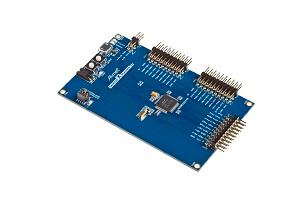SAM D20 Xplained Pro Evaluation Kit
Overview
The SAM D20 Xplained Pro evaluation kit is ideal for evaluation and prototyping with the SAM D20 Cortex®-M0+ processor-based microcontrollers. The kit includes Atmel’s Embedded Debugger (EDBG), which provides a full debug interface without the need for additional hardware.

Hardware
ATSAMD20J18 ARM Cortex-M0+ processor at 48 MHz
32.768 kHz crystal oscillator
256 KiB flash memory and 32 KiB of RAM
One yellow user LED
One mechanical user push button
One reset button
On-board USB based EDBG unit with serial console
Supported Features
The atsamd20_xpro board configuration supports the following hardware features:
Interface |
Controller |
Driver/Component |
|---|---|---|
NVIC |
on-chip |
nested vector interrupt controller |
Flash |
on-chip |
Can be used with LittleFS to store files |
SYSTICK |
on-chip |
systick |
WDT |
on-chip |
Watchdog |
GPIO |
on-chip |
I/O ports |
USART |
on-chip |
Serial ports |
SPI |
on-chip |
Serial Peripheral Interface ports |
Other hardware features are not currently supported by Zephyr.
The default configuration can be found in the Kconfig boards/arm/atsamd20_xpro/atsamd20_xpro_defconfig.
Connections and IOs
The Microchip website 1 has detailed information about board connections. Download the SAM D20 Xplained Pro Schematic 2 for more detail.
System Clock
The SAMD20 MCU is configured to use the 32.768 kHz external oscillator with the on-chip PLL generating the 48 MHz system clock.
Serial Port
The SAMD20 MCU has 6 SERCOM based USARTs. One of the USARTs (SERCOM3) is connected to the onboard Atmel Embedded Debugger (EDBG). SERCOM4 is available on the EXT1 connector.
SPI Port
The SAMD20 MCU has 6 SERCOM based SPIs. On the SAM D20 Xplained Pro, SERCOM0 is available on the EXT1 connector.
Programming and Debugging
The SAM D20 Xplained Pro comes with a Atmel Embedded Debugger (EDBG). This provides a debug interface to the SAMD20 chip and is supported by OpenOCD.
Flashing
Build the Zephyr kernel and the Hello World sample application:
west build -b atsamd20_xpro samples/hello_worldConnect the SAM D20 Xplained Pro to your host computer using the USB debug port.
Run your favorite terminal program to listen for output. Under Linux the terminal should be
/dev/ttyACM0. For example:$ minicom -D /dev/ttyACM0 -o
The -o option tells minicom not to send the modem initialization string. Connection should be configured as follows:
Speed: 115200
Data: 8 bits
Parity: None
Stop bits: 1
To flash an image:
west build -b atsamd20_xpro samples/hello_world west flash
You should see “Hello World! arm” in your terminal.
